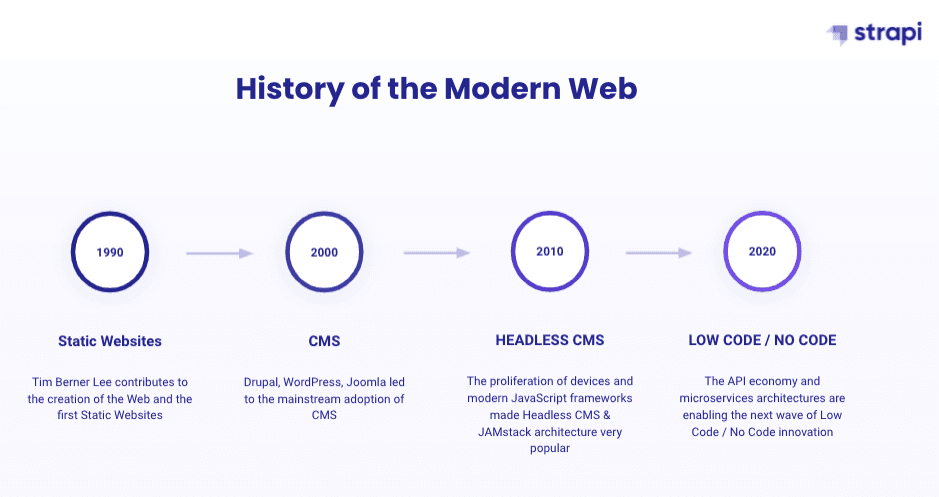
Low-Code, Headless or No-Code for CMS? Which Model to Choose?
WEB DEVELOPMENT, INFRASTRUCTURE.
What is the "No-Code" model for CMS?
The No-Code model refers to the use of tools for software development without the need to write code. These tools work independently of the user's skills or technical knowledge of languages, operating systems or libraries.
They are developed for specific cases and provide the user with an accessible interface in which there is some availability of pre-designed building blocks and templates.
In the case of CMS, these tools can be used to develop the site and then create content on it, so it is possible to customize it according to the requirements and needs of the company.

What is the Headless CMS and/or Low-Code model?
The Headless and/or Low-Code model is a CMS that only works with Back-End (it does not have a built-in Front-End, hence its name "Headless"), and whose operation is similar to that of a content repository. The accessibility to these contents is done from an API that allows them to be visualized in any device and through any media or platform.
Headless CMSs have become an excellent solution for these times, where the number of devices or platforms connected to the Internet is increasing. This type of Low-Code content management system allows companies to create and develop omnichannel digital experiences for their customers.
Thanks to their high level of abstraction and the possibility to customize what is created with them, Headless CMS is a Low-Code solution that considerably reduces the complexity and time spent for development.
Benefits and limitations of the No-Code CMS model
Before using the No-Code model for CMS it is necessary that you take into consideration all the benefits and limitations of it. Below we explain the most relevant ones:
Benefits:
Selling times
One of the main benefits offered by this model is that it makes the product commercialization process considerably more efficient. Thanks to its pre-designed templates and basic components, it is often faster to move an idea or niche to a MVP (Minimum Viable Product), even if it is a production-ready application or website.
This decrease in product time-to-market proves to be very beneficial and important for companies to innovate much faster.
It does not depend on the developers
Hiring IT professionals or developers has become necessary for companies that decide to invest in their digital transformation. However, No-Code tools for CMSs allow some autonomy to non-technical teams, and are very attractive for businesses looking for a simpler web presence and content dissemination.
Lower cost
The considerable reduction in development time, pre-designed templates, pre-built components and already configured hosting are elements that represent significant savings for companies that take advantage of No-Code tools in their digital transformation. They also work very well for the development of prototypes or simple projects.
Limitations:
Is Dogmatic
Tools of this type are usually developed for specific purposes, which can range from website creation to project management and automation. In other words, there are No-Code tools for almost every use.
However, the limitations begin once the developed project grows beyond the simple and standardized use for which the No-Code tool was created, extending across different devices and systems, which can generate a serious problem.
It may be necessary to use several No-Code tools in parallel, instead of building a practical and moldable software, on a platform that can be customized or expanded to be adapted to any case, to different requirements and to multiple channels.
Technical debt
These are the results that are obtained when a development team focuses on speed and ease of use for the design of a software instead of its scalability and evolution for the future. This generates limitations in the medium and even short term, and this is something that happens with No-Code tools.
This is due, in part, to the fact that No-Code tools are designed without following standard development best practices, and also, in most cases, documentation on their use is very limited.
Cost - Blocking
It is no secret that cybersecurity risks are increasing day by day and parallel to this the new GDPR regulations are becoming more and more common. All companies should be very cautious when choosing the CMS provider they plan to work with.
The use of No-Code tools can be convenient from many points of view, however, it can generate problems related to data governance. In addition, once the number of contents starts to expand, such solutions can become much more expensive and migration to another platform is not possible.
Associated Technologies / Headless Examples
There are a variety of platforms that offer this type of solutions for companies or businesses looking for an optimal way to create and publish content on the different channels and devices currently available. Among them, the following stand out:
Headless CMS:
It is one of the pioneers in Headless CMS as they were released long before they started to become as popular as they are today.
This platform stands out for offering publishers and authors many advantages that few CMSs of its kind provide, such as full preview, customization and in-context editing, among others.
It is one of the Headless open source CMS currently available. It is developed in JavaScript, whose features make it ideal for those projects that require custom databases.
One of the main advantages and attractions of this Headless CMS is that developers feel very comfortable working with it, since it works with the popular PHP programming language, which makes it ideal for companies that have a development team.
Contentful provides its users with a lot of benefits and advantages that make it one of the best and most affordable options for content creation and publishing. This is because thanks to its usability, Contentful provides a content infrastructure that can be used optimally by anyone with or without technical knowledge.
Additionally, developers have no restrictions and can use the framework and language they feel most comfortable working with, as this platform uses REST API development kits for all popular languages.
Its functionalities allow editors to work with content from anywhere and at any time, and it can be integrated with third-party services such as Dropbox, thus allowing existing services to be used without restriction.
Which one to choose: Low-Code / Headless or No-Code?
The criteria for choosing between these two types of tools should be based more on the needs and future requirements of the project in which they will be used, rather than on the advantages that one may have over the other.
It is important to identify the requirements and scope of each project to know which of these two is the most suitable tool. If you are a small company that needs to create a simple project or a PMV from an idea, with limited scope, security and data governance risks, a No-Code tool would be the best choice.
On the other hand, if it is a project with greater ambitions, such as an application with a wider and changing scope, where the use of third-party solutions is required and with several parties involved (designers, developers, editors, etc.), the best option is a Headless CMS, since this tool allows greater flexibility in workflows with these features.
The following are some questions to ask yourself before making the right decision:
Will the scope of your project change over time?
Does your project involve developers and do they typically use preferred tools and frameworks?
you plan to target your content to audiences across multiple channels?
Is user experience important to you?
Do you need to maintain security and data protection control?
If your answers to most or some of these questions are yes, the best choice for your project is undoubtedly a Headless CMS.